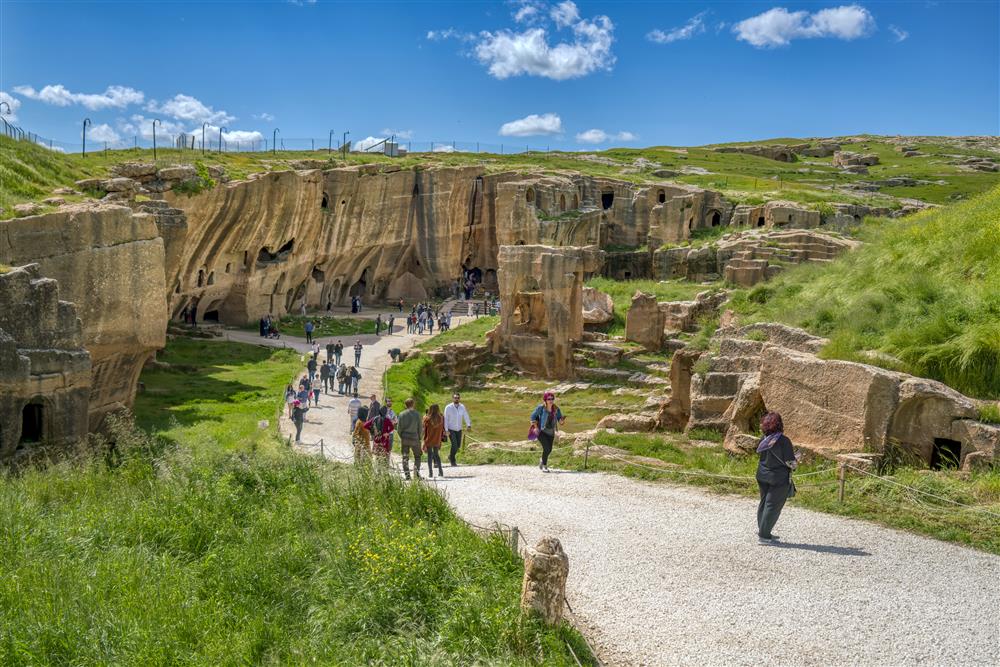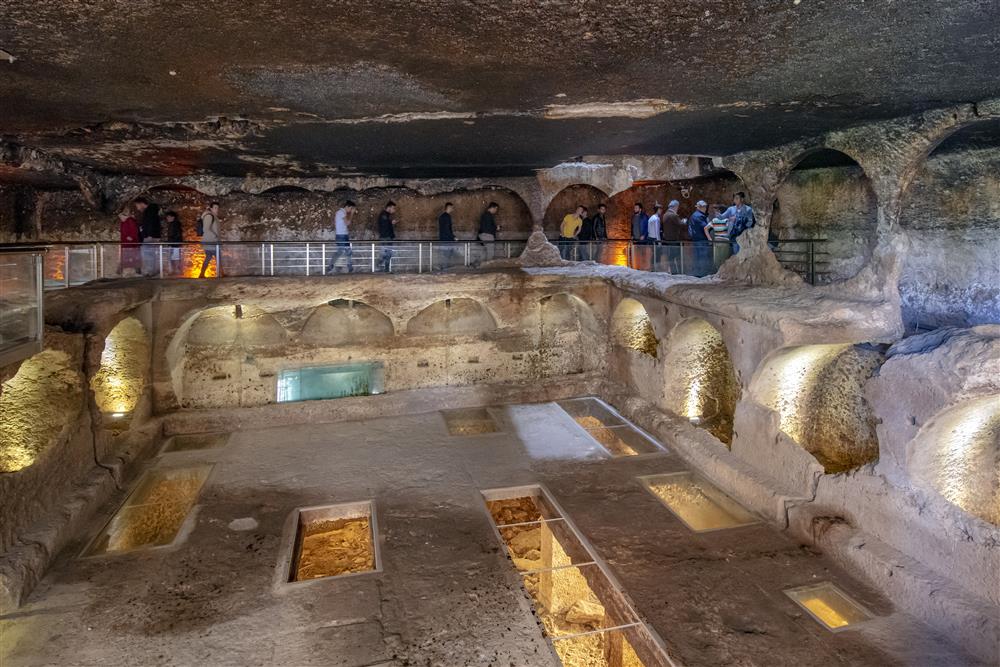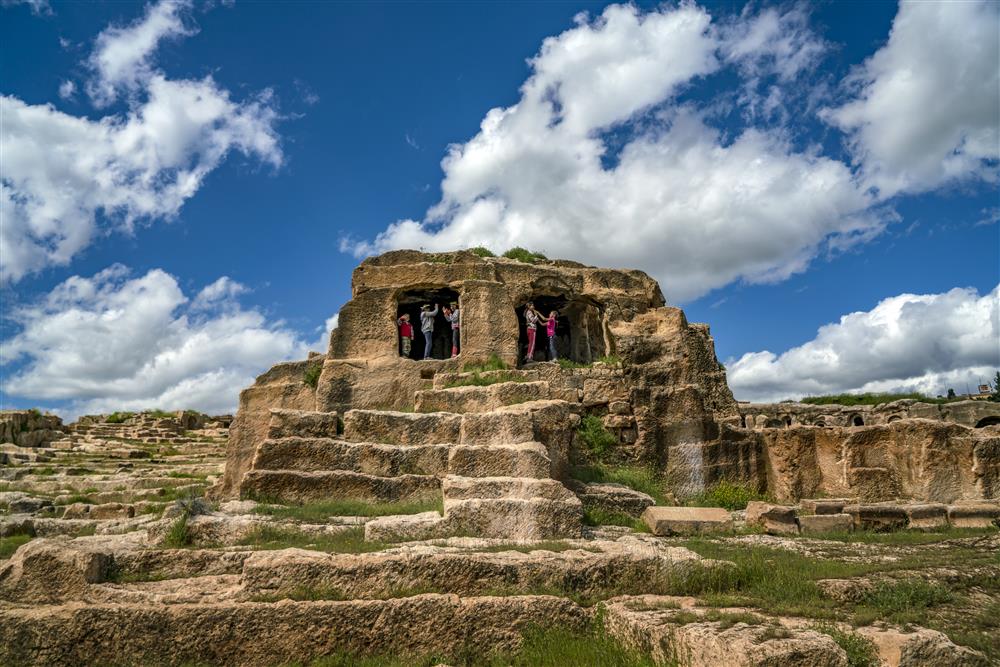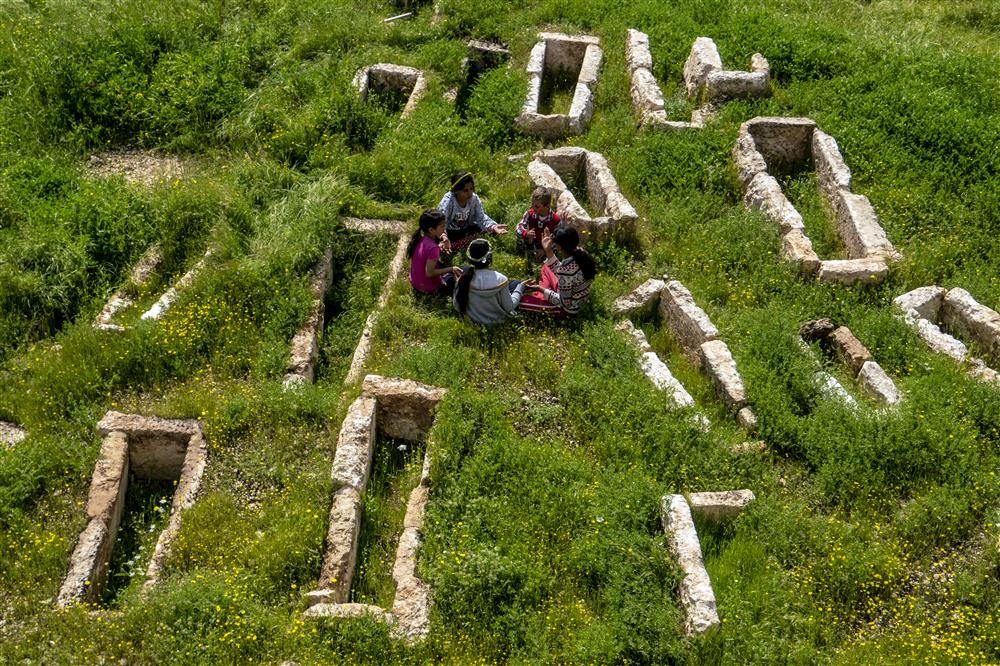YOLBUL (NAVIGATION)
Dara Antik Kenti Mardin’in 30 kilometre güneydoğusunda bulunan Oğuz Köyü'nde yer almaktadır. Tarihte Yukarı Mezopotamya'nın en önemli yerleşim yerlerinden birisi olan Dara, İmparator Anastasius'un (491-518) girişimleriyle 505 yılında, Doğu Roma İmparatorluğu’nun doğu sınırını Sasanilere karşı korumak için askeri amaçlı bir garnizon kenti olarak kurulmuştur. Roma İmparatorluğu'nun çöküşüyle şehir zaman içinde önemini yitirmiş ve harabeye dönmüştür.
Kaya içine
oyulan yapılardan oluşan ve geniş bir alana yayılan Dara Antik Kenti’nin
çevresi 4 kilometrelik bir surla korunmuştur. İç kale, kentin kuzeyinde
ve 50 metre yüksekliğindeki tepenin üst düzlüğüne kurulmuştur. Kent
içinde kilise, saray, çarşı, zindan, tophane ve su bendi kalıntıları
halen görülebilmektedir. Ayrıca köyün etrafında tarihleri Geç Roma
Dönemi’ne kadar giden mağara evlere rastlanmaktadır. Şehrin altında bulunan dev sarnıçlar ve kentin içinde yer alan koruma altına alınmış mezarlık görülmeye değer bir çok eserden bazılarıdır.
Dara'yla ilgili antik kaynaklara bakıldığında şehrin önemi daha iyi anlaşılacaktır. Örneğin Evagrius Scholasticus Dara için; Roma'nın en önemli sınır kalesi demiştir.
Yine başka bir Romalı tarihçi Marcus Junianus Justinus ise Dara'yı şöyle tasvir etmektedir; Seleucus Zapaortenon Dağı'nda, Dara adında bir şehir kurdu, öyle ki, hiçbir yer bundan daha güvenli veya daha hoş olamaz;çünkü o kadar sarp kayalarla çevrilidir ki, konumu nedeniyle gardiyana ihtiyacı yoktur.Dibindeki toprağın verimliliği o kadar fazladır ki, kendi ürünüyle birlikte depolanır.Bol su ırmaklarıyla beslenen bir çok pınar ve ağaç ve avın tüm zevkleriyle dolu bir yerdir burası.
Bazı tarihçilere göre Dünya tarihini değiştiren ve Büyük İskender'le III. Darius arasında gerçekleşen Gaugamela Muharebesi'de bu bölgede gerçekleşmiş ve bölgenin adı Darius'tan ilham alınarak Dara konulmuştur. Bu bilginin arkeolojik verilerle teyit edilmemesine ve Dara'nın bilinen tarihinin M.Ö 331 yılında gerçekleşen bu savaşla örtüşmemesine rağmen bölgenin savaşın gerçekleştiği sayılan Musul'daki bölgeyle olan benzerliği ve tarihi ipek yolu üzerinde konuşlanmış olması Dara'yı bu anlamda da değerli kılmaktadır.
Bölgeye toplu taşıma hizmeti bulunmamaktadır. Pazartesileri kapalıdır. Antik şehre girişler ücretsizdir.
ENGLISH- DARA THE ANTIQUE CITY-
Dara Ancient City is located in Oğuz Village, 30 kilometers southeast of Mardin. Dara, one of the most important settlements of Upper Mesopotamia in history, was established as a military garrison city in 505 with the initiatives of Emperor Anastasius (491-518) to protect the eastern border of the Eastern Roman Empire against the Sassanids. Upon the collapse of Roman Empire, the ancient city of Dara lost its importance and turned into ruins over the course of time.
The ancient city of Dara, which consists of structures carved into the rock and spread over a wide area, was protected by a 4-kilometer wall. The inner castle was built on the north of the city and on the upper plain of a 50-meter-high hill. The ruins of churches, palaces, bazaars, dungeons, armory and water dam can still be seen in the city. In addition, cave houses dating back to the Late Roman Period are found around the village. The giant cisterns and the common graves under protection are some of the must see places in the ancient town.
Dara's importance can be better understood by tracing the ancient courses. For example Evagrius Scholasticus described Dara as; The most important frontier fortress of Rome.
Yet another Roman historian, Marcus Junianus Justinus, describes Dara as follows;Seleucus founded a city also, called Dara, in Mount Zapaortenon, of which the situation is such, that no place can be more secure or more pleasant; for it is so encircled with steep rocks, that the strength of its position needs no defenders; and such is the fertility of the adjacent soil, that it is stored with its own produce. Such too is the plenty of springs and wood, that it is amply supplied with streams of water, and abounds with all the pleasures of the chace.
Further some historians claim that the battle of Gaugamela between Alexander the Great and Darius III took place at Dara. Hence the name of the region derived from the King Darius. This claim can't be verified with archeological evidences or even the known history of Dara does not dates to back to 331 BC -the date when battle made-. Yet Dara has similarities with the region in Mosul where the battle venue is believed to be located. Moreover, archeological excavations are still going on in Dara region and each day scientists are finding new evidences.
There is no public transport to the area. The city is closed to visits on mondays. Entrance is free of charge.

ESPANOL -DARA, LA CIUDAD ANTIGUA-
La ciudad antigua de Dara se encuentra en el pueblo de Oğuz, a 30 kilómetros al sureste de Mardin. Dara, uno de los asentamientos más importantes de la Alta Mesopotamia en la historia, se estableció como ciudad de guarnición militar en 505 con las iniciativas del emperador Anastasio (491-518) para proteger la frontera oriental del Imperio Romano de Oriente contra los sasánidas. Tras el colapso del Imperio Romano, la antigua ciudad de Dara perdió su importancia y se convirtió en ruinas con el transcurso del tiempo.
La antigua ciudad de Dara, que consta de estructuras excavadas en la roca y distribuidas en un área amplia, estaba protegida por un muro de 4 kilómetros. El castillo interior se construyó al norte de la ciudad y en la llanura superior de una colina de 50 metros de altura. Las ruinas de iglesias, palacios, bazares, mazmorras, armería y presa de agua aún se pueden ver en la ciudad. Además, alrededor del pueblo se encuentran casas cueva que datan de la época tardorromana. Los aljibes gigantes y las fosas comunes bajo protección son algunos de los lugares de visita obligada del casco antiguo.
La importancia de Dara se puede comprender mejor rastreando los cursos antiguos. Por ejemplo, Evagrius Scholasticus describió a Dara como; La fortaleza fronteriza más importante de Roma.
Otro historiador romano, Marcus Junianus Justinus, describe a Dara de la siguiente manera; Seleuco fundó también una ciudad, llamada Dara, en el monte Zapaortenon, de la cual la situación es tal, que ningún lugar puede ser más seguro ni más agradable; porque está tan rodeada de escarpadas rocas, que la fuerza de su posición no necesita defensores; y tal es la fertilidad del suelo adyacente, que se almacena con su propio producto. Tanta es también la abundancia de manantiales y leña, que está ampliamente provista de corrientes de agua, y abunda con todos los placeres del azar.
Además, algunos historiadores afirman que la batalla de Gaugamela entre Alejandro Magno y Darío III tuvo lugar en Dara. De ahí el nombre de la región derivado del rey Darío. Esta afirmación no se puede verificar con evidencias arqueológicas o incluso la historia conocida de Dara no se remonta al 331 aC -fecha en la que se produjo la batalla-. Sin embargo, Dara tiene similitudes con la región de Mosul donde se cree que se encuentra el lugar de la batalla. Además, todavía se están realizando excavaciones arqueológicas en la región de Dara y cada día los científicos encuentran nuevas evidencias.
No hay transporte público a la zona. Dará está cerrada a visitar en lunes. La entrada es gratuita

РУССКИЙ ДАРА АНТИЧНЫЙ ГОРОД-
Древний город Дара расположен в деревне Огуз, в 30 км к юго-востоку от Мардина. Дара, одно из самых важных поселений Верхней Месопотамии в истории, была основана как военный гарнизон в 505 году по инициативе императора Анастасия (491-518) для защиты восточной границы Восточной Римской империи от Сасанидов. После распада Римской империи древний город Дара потерял свое значение и со временем превратился в руины.
Древний город Дара, состоящий из сооружений, вырубленных в скале и раскинувшихся на обширной территории, был защищен 4-километровой стеной. Внутренний замок был построен к северу от города и на верхней равнине 50-метрового холма. В городе до сих пор можно увидеть руины церквей, дворцов, базаров, подземелий, арсеналов и водохранилищ. Кроме того, вокруг деревни находятся пещерные дома позднеримского периода. Гигантские цистерны и братские могилы, находящиеся под защитой, являются одними из обязательных к посещению мест в древнем городе.
Важность Дары можно лучше понять, проследив древние курсы. Например, Евагрий Схоластик описал Дару как; Важнейшая пограничная крепость Рима.
Еще один римский историк, Марк Юниан Юстин, описывает Дару следующим образом; Селевк также основал город, называемый Дара, на горе Запаортенон, положение которой таково, что нет места более безопасного и приятного; ибо он так окружен крутыми скалами, что сила его положения не нуждается в защитниках; плодородие соседней почвы таково, что она запасается собственными плодами. Также так много родников и леса, что он обильно снабжается потоками воды и изобилует всеми удовольствиями охоты.
Далее некоторые историки утверждают, что битва при Гавгамелах между Александром Македонским и Дарием III произошла при Даре. Отсюда и название региона, полученное от царя Дария. Это утверждение не может быть подтверждено археологическими свидетельствами, и даже известная история Дары не восходит к 331 г. до н.э. — дате начала битвы. Тем не менее, Дара имеет сходство с районом в Мосуле, где, как считается, находится место сражения. Кроме того, в Даринском районе до сих пор продолжаются археологические раскопки, и каждый день ученые находят новые свидетельства.
В районе нет общественного транспорта. Город закрыт для посещения по понедельникам. Вход бесплатный.




Kaynaklar (sources)
http://www.forumromanum.org/literature/justin/english/trans41.html
https://dergipark.org.tr/tr/download/article-file/611025
https://books.google.com.tr/books?redir_esc=y&hl=tr&id=YP9cuh3KX3wC&q=dara#v=snippet&q=dara&f=false